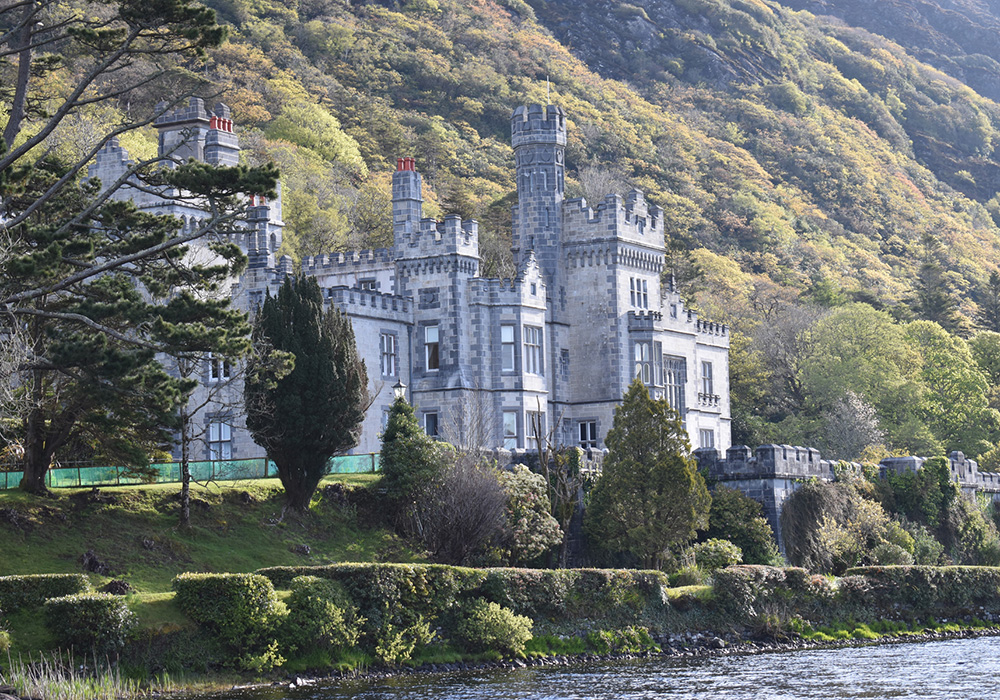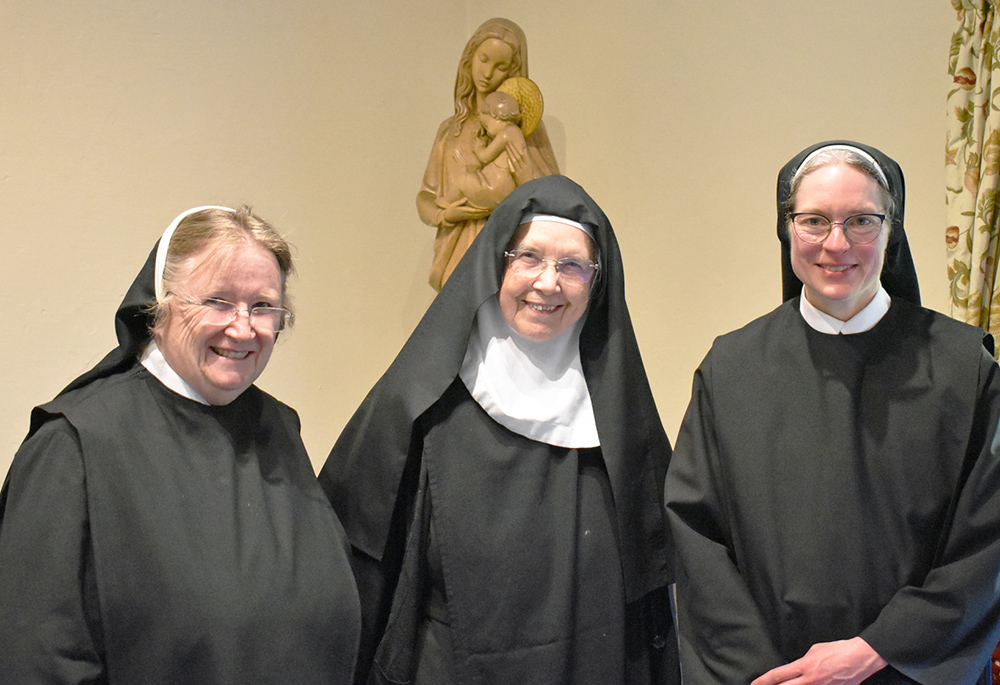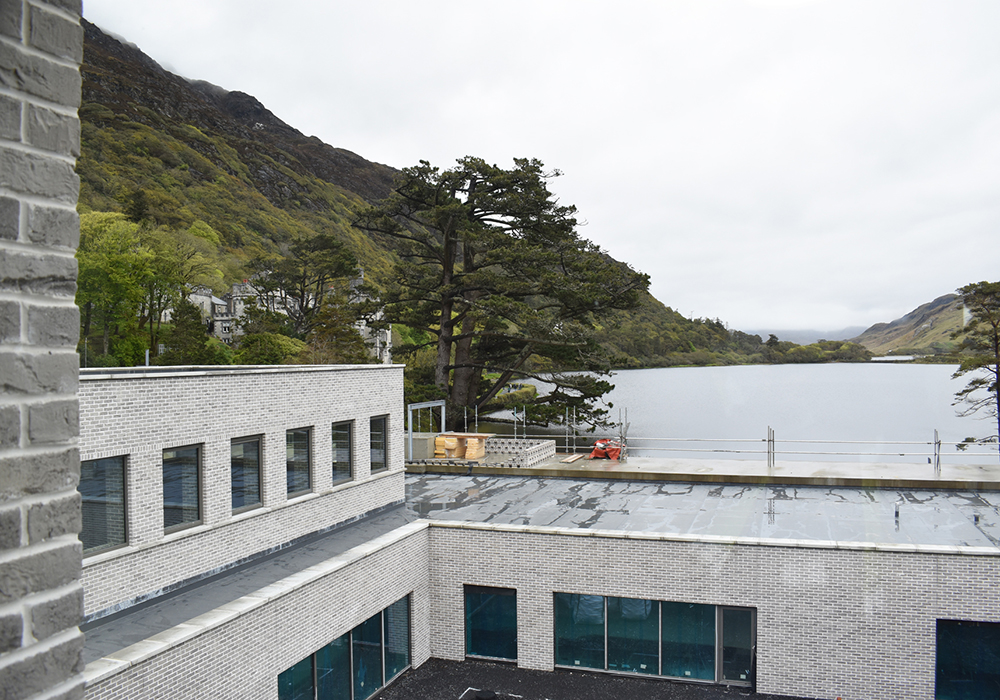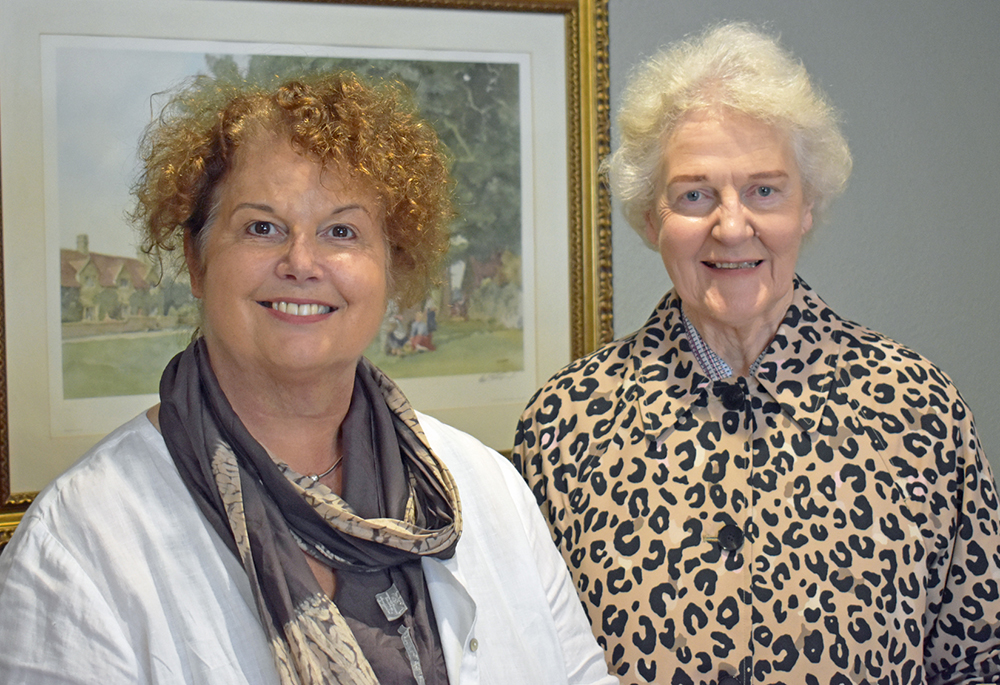
Kylemore Abbey in Connemara, Ireland (Julie A. Ferraro)
In past millennia, construction of a church could take centuries. Paris' Cathedral of Notre Dame — currently in the final stages of being rebuilt after the tragic fire that nearly destroyed it in 2019 — took nearly 200 years to complete.
Technology in the modern era may have vastly reduced construction time for churches and other religious structures, but other factors can cause really long delays in seeing the final brick being mortared in place.
Such is the case for the Benedictine Sisters at Kylemore Abbey in Connemara, Ireland — one of only two women's Benedictine communities in the country, and the first women's Benedictine monastery to be built in Ireland in over 400 years, according to their website.
As Kylemore's retired abbess Mother Máire Hickey reflected, a group of Benedictine nuns, known as the "Irish Dames of Ypres," left the Royal Abbey of the Immaculate Conception in Belgium in 1914 — during World War I — hoping someday to return.
"They were literally walking ahead of the bombs," said Catherine KilBride, an educator, historian and translator who, with Deirdre Raftery, a full professor of the history of education at the University College Dublin School of Education, and an elected fellow of the Royal Historical Society, authored The Benedictine Nuns & Kylemore Abbey: A History.

Left to right: Sr. Karol O'Connell , Mother Máire Hickey and Sr. Jeanne Bott (Julie A. Ferraro)
Archived records from that era recount how one of the sisters, returning through the battle lines for a last look before leaving the district, saw the damage already inflicted on the monastery, which would ultimately be reduced to rubble, recalled Hickey.
"That was when the sisters realized they'd never be able to go back," she said, adding that she feels very connected to those sisters, and the ones who followed in their footsteps.
The displaced religious wondered where the funds would come from to build a new monastery as they made their way to England, then to Ireland, Hickey continued.
From that point to 2024, the dream of a monastery remained alive for the Benedictine community.
The Benedictines took possession of Kylemore Castle along Ireland's Wild Atlantic Way in 1920, related Hickey, renaming it Kylemore Abbey. The former home of Mitchell Henry, a doctor and member of Parliament in the 19th century, the vast structure was completed only six years prior to the untimely death of his wife, Margaret. While Henry and his children continued to maintain the castle, which changed hands in the early 1900s before being abandoned by its last owner in 1914.
The castle and its surrounding 1,000 acres really didn't qualify as a monastery though, as Raftery stated, the local bishop rejected the community's claim of a lack of enclosure with the logic that the surrounding mountains supplied a natural enclosure.

Many of the Benedictine sisters will have glorious views of Lough Pollacappul and the historic Kylemore Abbey from their rooms in the new monastery. (Julie A. Ferraro)
While true — "There was no one around," KilBride noted of the isolated location, with Raftery adding, "nothing for miles" — the sisters persisted in their plans for an actual monastery while living in the massive stone residence overlooking Lough Pollacappul.
The community opened a boarding school for girls as their primary ministry. As student enrollment increased, an annex was built adjacent to the castle, where the sisters resided. This configuration of the space, however, did not allow the community to enjoy a proper cloister, for one — something essential to religious life.
In the early 2000s, plans for building a monastery were revitalized. The Benedictines moved out of the castle and annex to a farmhouse and other small structures around the sprawling property in 2007, Hickey said. They've lived in those quarters ever since.
The community closed their boarding school in 2010 and, while Kylemore had become a popular tourist destination as early as the 1990s, the castle's ground floor was gradually transformed into a museum, allowing visitors a glimpse of not only the lives of the Henry family, but the history of the Benedictines.
In the meantime, realization of the sisters' goal inched closer.

The Benedictine Sisters of Kylemore Abbey have used this farmhouse as their common space since 2007, while waiting for their dream of a new monastery to come to fruition. (Julie A. Ferraro)
The lay staff of the Kylemore Trust — the charity created to both support the sisters and preserve the historic value of the castle, the neo-Gothic chapel and other buildings, and Victorian walled garden — shared in the enthusiasm of the project's development, as noted by Jessica Ridge, an alumna of the Benedictines' boarding school who serves as marketing manager.
"The staff knows the nuns," Ridge said. "And through this process they've grown to understand why the nuns are so deeply connected to Kylemore as part of the Benedictine vow of stability."
In 2018, permission was granted by the Galway County Council to begin construction.
Hickey laid the first brick for the new monastery on Feb. 13, 2020. Then, the COVID-19 pandemic brought the process to a screeching halt. What had originally been planned as a five-year project faced the challenge of obtaining an extension.
Hickey retired in August 2022 as abbess after 14 years of leadership.
Srs. Karol O'Connell and Jeanne Bott currently serve as co-superiors for the international community of 14 — including sisters from Ireland, Germany, Italy, India, Australia, Martinique and Asia. The pair have overseen how the unique complex has risen from there.
"It'll be a blessing not to be so cramped, on top of each other," O'Connell said, comparing the sisters' current quarters to the new building. For those not living in the farmhouse, "We'll get to see each other more."
The waiting has been a test of patience, nonetheless.
"Thankfully for all concerned, the monastery construction kicked off again in January 2023," said Padraig Headd, senior contract manager for Carey Building Contractors, Galway. "We are on target for completing the main building by the end of June 2024."
Meeting that deadline has not been without its challenges, as site manager David Connor attested. A monastery designed with extensive custom brickwork, vaulted ceilings and numerous windows for natural lighting called for the top craftsmen in multiple trades.
"It was painful for the plasterers doing the arches by hand," Connor said. Yet, when one portion of that specific job met with approval, the sense of satisfaction at work well done was tangible.

David Connor, Carey Building Contractor’s site manager on the Kylemore monastery project, explains the intricate brickwork around the high windows created for the multipurpose room. (Julie A. Ferraro)
Connor mentioned another obstacle: the weather. An unusual pattern of frequent rain meant delays enclosing the structure so it was watertight. Yet, "It's not every day a monastery is built," he admitted. "You just have to look for the silver lining."
Part of that silver lining will be the sense of accomplishment when the final sections of scaffolding are taken down, Connor acknowledged. Creating the sisters' living spaces — a community room with a kitchenette and electric fireplace, a large refectory (dining room), an elevator, cloister garden surrounded by a tall, curved brick wall outside the chapter room where windows are set high above unique concrete pillars, comfortable individual bedrooms (with incredible views of the lake and castle on the upper level), and the courtyard garden (or garth) surrounded on all four sides by full-length windows so the sisters can look out on the beauty as they move from place to place — has never been dull.
"Every little corner is different," he said.
As for the public spaces, the timber-paneled reception area opens on a two-story tall multipurpose room lit from all four directions by large windows framed with layered brickwork. "The bricks had to be sent to England," Connor said. "They took 12 weeks to manufacture."
The chamber's open floor plan will allow for a variety of events, with meeting rooms for smaller groups along a side corridor, and guest accommodations for those seeking silence or attending retreats.
Connor confirmed, "There's so much they're going to do with the building."
Advertisement
In the meantime, the sisters have endured praying the Liturgy of the Hours with power saws buzzing beyond the walls of the boarding school's former gymnasium — artistically renovated as the chapel some years ago — or pipes clattering on the ground in the middle of the weekday eucharistic celebration. Still, many other factors fuel the community's excitement about their new space.
The Kylemore managers, supervisors and staff have had a chance to tour the inside of the new building, Ridge said. After growing accustomed to the castle as the monastery, "We've gotten to see what a real monastery looks like."
There are plans in place to shift the emphasis from Kylemore Abbey as a tourist destination to that of welcoming visitors to the Benedictines' home and sharing the prayer-work-study balance essential to Benedictine spirituality.
"We'll be more accessible to the pilgrims," O'Connell said, who prefers "pilgrims" to "tourists."

Jessica Ridge, marketing manager for Kylemore Abbey (Julie A. Ferraro)
Already, the Kylemore employees have attended sessions where materials like an 8-page document detail what the nuns are about, Ridge said. "We want to share that with everyone."
"Women discerning their vocation will be able to witness how the Benedictine values are lived in community," said Bott, who also serves as vocation director for the community.
Having the facilities to offer retreat programming and educational opportunities — especially on the topics of ecology and the environment — will be possible with the new monastery, she said.
Also nice, O'Connell mentioned, will be not having to hike — or drive — the distance from the farmhouse to the chapel multiple times each day. A corridor will be all that separates the sisters from gathering for the Divine Office and liturgies. "We'll be in a position to invite more people to join in the prayers."
The Benedictines eagerly await moving day, when they will live together under the same roof. A blessing of the Monastery of the Immaculate Conception — named in honor of their predecessors' monastery in Ypres — is scheduled for mid-August, followed by a series of weekend gatherings when boarding school alumnae, the sisters' friends and family, other religious communities and many others will have opportunities to view the finished monastery.
Once the sisters are settled in, an election for the next abbess will take place in September.
Mother Máire Hickey is mindful that, over the course of 110 years, a long line of individuals contributed to reaching this point in time.
"I have deep, deep gratitude to all those whose generosity and commitment have made this possible," she said. "I feel inspired, privileged to be involved in passing on the message of Benedict and Scholastica to a new generation, and energized to give all I have."













